#Andronicus of Cyrrhus
Photo






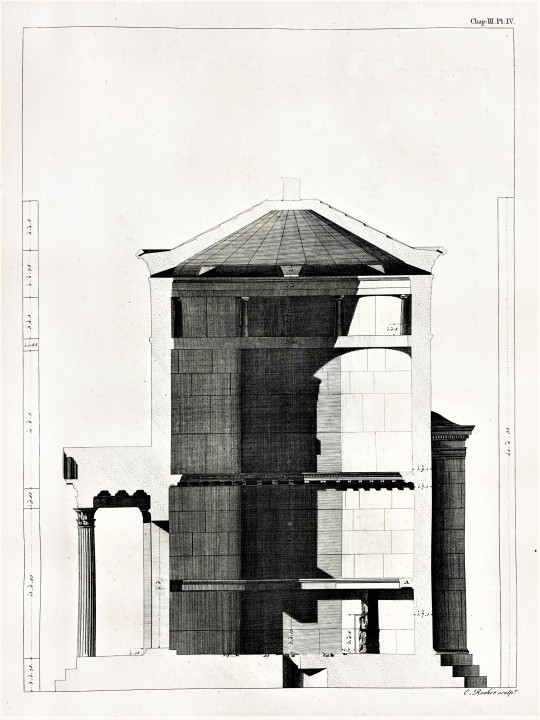
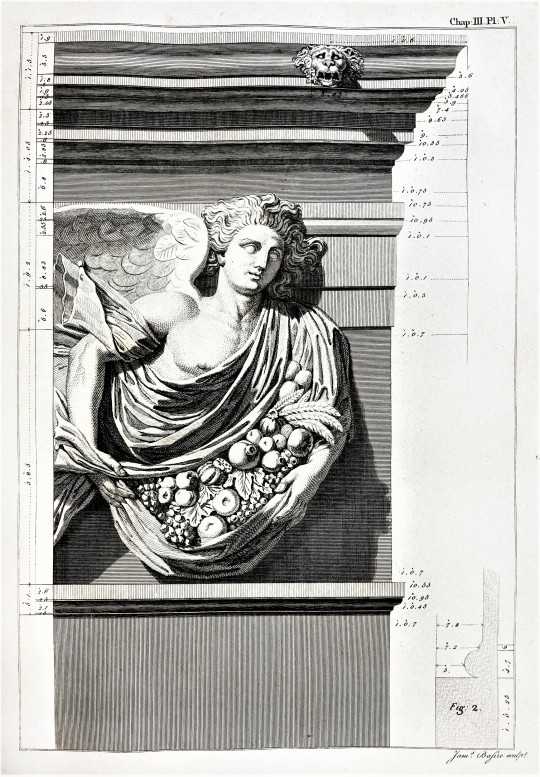


Decorative Sunday!
These beautiful engravings are from the first volume of The Antiquities of Athens by Scottish archeologist, architect and artist, James Stuart (1713-1788) and British artist and architect, Nicholas Revett (1720-1804), printed in London by John Haberkorn in 1762.
The Tower of the Winds is an octagonal marble clock tower in the Roman Agora of Athens. It was designed by Andronicus of Cyrrhus around 50 BC. It was a functional structure that contained sundials, a waterclock, and a wind vane. It is an ancient equivalent of a modern day meteorological station. The building became more widely known outside of Greece because of Stuart and Revett, who were among the first to document the antiquities and monuments of Athens in great architectural detail. Their work is noted for fueling the Greek Revival, an architectural movement in northern Europe, the United States, and Canada in the late 18th and early 19th centuries. When the first volume was published they had more than five hundred subscribers, mostly architects and builders.
The engravings were made by the British engraver James Basire (1730-1802), who specialized in prints depicting architecture. Artwork by Basire is held in museums throughout the world. He is also known for having the young William Blake (1757-1827) as an apprentice for seven years.
The well known artist William Hogarth (1697-1764) published a satirical print called The Five Orders of Periwigs in which he classifies the ridiculous wigs that were in fashion at the time into “orders” with greatly detailed measurements. This was a direct satire of Stuart and Revett’s work and similar work of which he said “It requires nor more skill to take the dimensions of a pillar or cornice, than to measure a square box.”
The tower’s frieze depicts the eight winds in bas-relief represented figuratively as gods, the Anemoi: Zephyrus, the West wind; Boreas, the North wind; Kaikias, the North East wind; Apeliotes, the East wind; Eurus, the South East wind; Notus, the South wind; Lips, the South West wind; and Sciron, the North West wind.
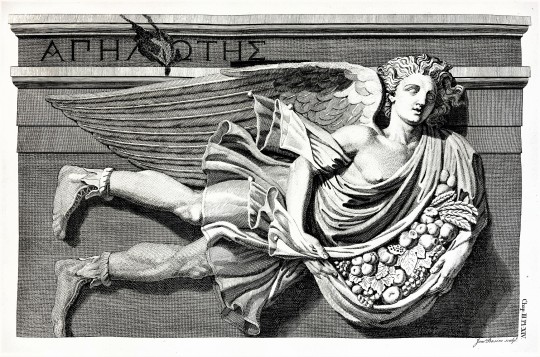
Apeliotes, The East Wind.
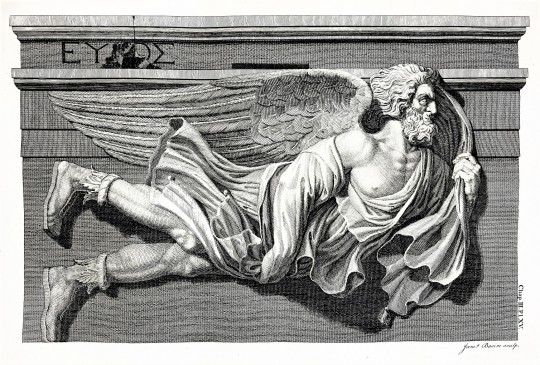
Eurus, The South East Wind.

Notos, The South Wind.

Lips, The South West Wind.

Sciron, The North West Wind.
View more Decorative Sunday posts.
-Teddy, Special Collections Graduate Intern
#Decorative Sunday#decorate plates#decorative arts#tower of the winds#athens#greek mythology#greek architecture#architecture#the antiquities of athens#james stuart#nicholas revett#James Basire#Andronicus of Cyrrhus#John Haberkorn#William hogarth#weathervanes#Engravings#18th century#greek sculpture#roman mythology#roman architecture#archeology#Teddy#Roman Agora#athens greece#Ancient Greece
102 notes
·
View notes
Text

Looking up at the Tower of the Winds in Athens, it's hard not to feel awestruck by the incredible engineering and design that went into this ancient structure. Built over 2,000 years ago, the Tower of the Winds served as a weather vane, sundial, and water clock. Its eight sides represent the eight wind directions and is adorned with a unique relief sculpture depicting a different wind deity.
Standing at 42 feet tall, the Tower of the Winds was built by the Greek astronomer Andronicus of Cyrrhus and is still standing strong today. It's a testament to the ingenuity and innovation of ancient Greek engineers and a reminder of the incredible advancements they made in science and technology.
Walking around the base of the tower, it's easy to imagine what life was like in ancient Athens. The bustling city streets, the markets full of fresh food and handmade crafts, and the sounds of people going about their daily lives. The Tower of the Winds would have been a beacon, guiding people through the city and helping them keep track of time and weather.
#goexploregreece#greece#travel#mustsee#mustvisit#greek#europe#beautiful views#athens#ancient site#ancient buildings#history#travel tips#traveling#travelling#athens city#top tips
4 notes
·
View notes
Text
Assignment 7# - Tower of the Winds


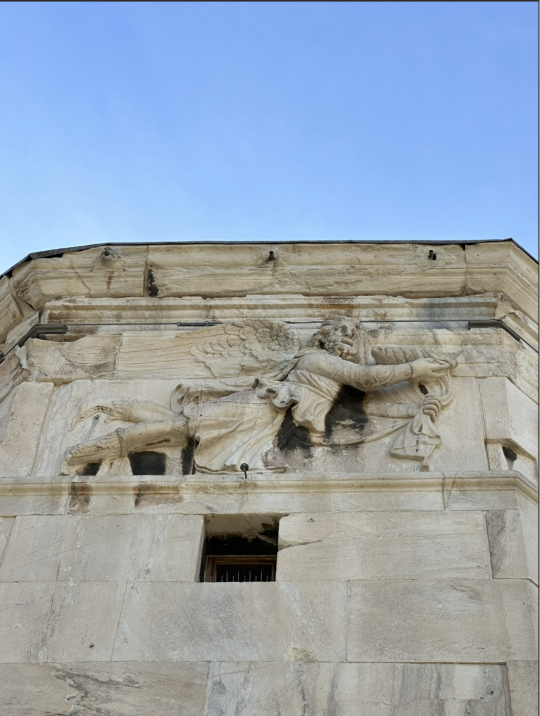
The Tower of the Winds, designed by Andronicus of Cyrrhus around 50 BC, served various purposes over time. Initially part of Athens' reconstruction after Roman destruction in 86 BC, it later functioned as a martyrium or religious space in late antiquity. Under Ottoman rule, it was buried, later excavated, and used by Qadirî dervishes from 1751 to 1821.
0 notes
Text


The Tower of the Winds or the Horologion of Andronikos Kyrrhestes is an octagonal Pentelic marble clocktower in the Roman Agora in Athens that functioned as an horologion or "timepiece". It is considered the world's first meteorological station. It was supposedly built by Andronicus of Cyrrhus (Macedonian Syria) around 50 BC, but according to other sources, might have been constructed in the 2nd century BC before the rest of the forum.
The 12-meter-tall structure has a diameter of about 8 meters and was topped in antiquity by a weathervane-like Triton that indicated the wind direction. Below is the frieze depicting the eight wind deities ~ Boreas ( N ), Kaikias (NE), Apeliotes (E), Eurus (SE), Notus (S), Lips (SW), Zephyrus (W), and Skiron (NW) ~ there are eight sundials. In its interior, there was a water clock (or clepsydra), driven by water coming down from the Acropolis.
138 notes
·
View notes
Photo


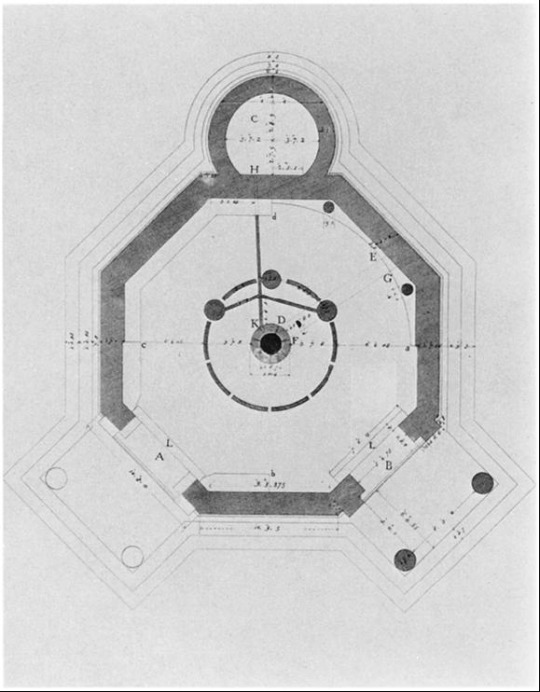


The Tower of the Winds or the Horologion of Andronikos Kyrrhestes is an octagonal Pentelic marble clocktower in the Roman Agora in Athens that functioned as a horologion or "timepiece". It is considered the world's first meteorological station. Unofficially, the monument is also called Aerides (Greek: Αέρηδες), which means Winds. The structure features a combination of sundials, a water clock, and a wind vane. It was supposedly built by Andronicus of Cyrrhus around 50 BC, but according to other sources, might have been constructed in the 2nd century BC before the rest of the forum. In summer of 2014, the Athens Ephorate of Antiquities began cleaning and conserving the structure; restoration work was completed in August 2016.
34 notes
·
View notes
Photo

The Tower of the Winds in Athens, in the Roman Agora, was one of the world’s first clock towers. It was built around 50 BC, and designed by the Macedonian astronomer Andronicus of Cyrrhus.
An enormous water clock was housed inside, fed every 24hrs by a stream running down from the Acropolis. As the water level rose, a float rose, powering a mechanism that showed the progress of the sun across the sky.
The lines of sundials can still be seen on the walls, as another way of telling the time (so long as the sun was shining). A bronze figure of Triton was placed on top as a weather-vane.
369 notes
·
View notes
Photo



TOWER OF THE WINDS:
THE Tower of the Winds, also known as the Clock of Andronicus Cyrrhestes, is a timekeeping tower on the eastern side of the Roman agora of Athens. Built in the 2nd century BCE, it once had nine sundials and contained a large water clock. Recently cleaned and restored, visitors can now finally enter the tower as part of the visit to the agora.
The Tower of the Winds in Athens, as indicated by an inscription on one sundial, was built by the astronomer Andronikos (Andronicus), son of Hermias, and from Kyrrhos (Cyrrhus) in ancient Macedon, and so it became known as the Horologion of Kyrrhestos. The precise date of the tower's construction is not recorded and, although some scholars suggest on astronomical grounds it was built in the early 1st century BCE, the majority of historians give greater weight to the architectural style which suggests construction in the 2nd century BCE.
Read More
Article by Mark Cartwright on AHE
252 notes
·
View notes
Text
2.Early Empire
Life in Greece continued under the Roman Empire much the same as it had previously. Roman culture was highly influenced by the Greeks; as Horace said, Graecia capta ferum victorem cepit ("Captive Greece captured her rude conqueror") [3]. The epics of Homer inspired the Aeneid of Virgil, and authors such as Seneca the younger wrote using Greek styles. While some Roman nobles regarded the Greeks as backwards and petty, many others embraced Greek literature and philosophy. The Greek language became a favorite of the educated and elite in Rome, such as Scipio Africanus, who tended to study philosophy and regard Greek culture and science as an example to be followed.
Similarly, most Roman emperors maintained an admiration for things Greek in nature. The Roman Emperor Nero visited Greece in AD 66, and performed at the Ancient Olympic Games, despite the rules against non-Greek participation. He was honored with a victory in every contest, and in the following year he proclaimed the freedom of the Greeks at the Isthmian Games in Corinth, just as Flamininus had over 200 years previously. Hadrian was also particularly fond of the Greeks; before he became emperor he served as an eponymous archon of Athens. He also built his Arch of Hadrian there.
Many temples and public buildings were built in Greece by emperors and wealthy Roman nobility, especially in Athens. Julius Caesar began construction of the Roman agora in Athens, which was finished by Augustus. The main gate, Gate of Athena Archegetis, was dedicated to the patron goddess of Athens, Athena. The Agrippeia was built in the center of the newly built Roman Agora by Marcus Vipsanius Agrippa. The Tower of the Winds was built by Andronicus of Cyrrhus in 50 BC, although it may predate the entire Roman section of Athens. The emperor Hadrian was a philhellene and an ardent admirer of Greece and, seeing himself as an heir to Pericles, made many contributions to Athens. He built the Library of Hadrian in the city, as well as completing construction of the Temple of Olympian Zeus, some 638 years after its construction was started by Athenian tyrants, but ended due to the belief that building on such a scale was hubristic. The Athenians built the Arch of Hadrian to honor Emperor Hadrian. The side of the arch facing the Athenian agora and the Acropolis had an inscription stating "This is Athens, the ancient city of Theseus." The side facing the Roman agora and the new city had an inscription stating "This is the city of Hadrian, and not of Theseus." Adrianou (Hadrian Street) exists to this day, leading from the arch to the Roman agora.
The Pax Romana was the longest period of peace in Greek history, and Greece became a major crossroads of maritime trade between Rome and the Greek speaking eastern half of the empire. The Greek language served as a lingua franca in the East and in Italy, and many Greek intellectuals such as Galen would perform most of their work in Rome.
During this time, Greece and much of the rest of the Roman east came under the influence of Early Christianity. The apostle Paul of Tarsus preached in Philippi, Corinth and Athens, and Greece soon became one of the most highly Christianized areas of the empire.
1 note
·
View note
Photo

Andronicus of #Cyrrhus #Horologium, Tower of the #Winds #Athens (at Tower of the Winds)
0 notes